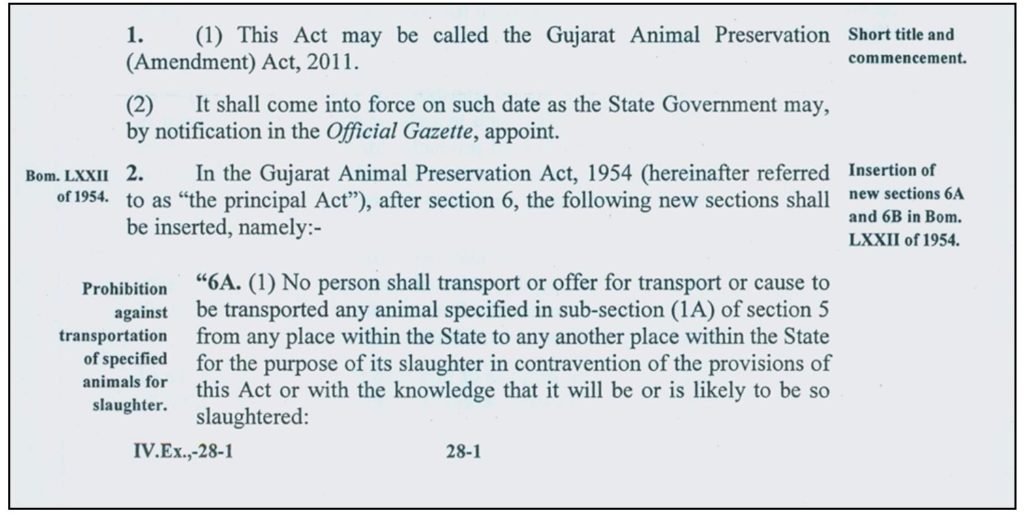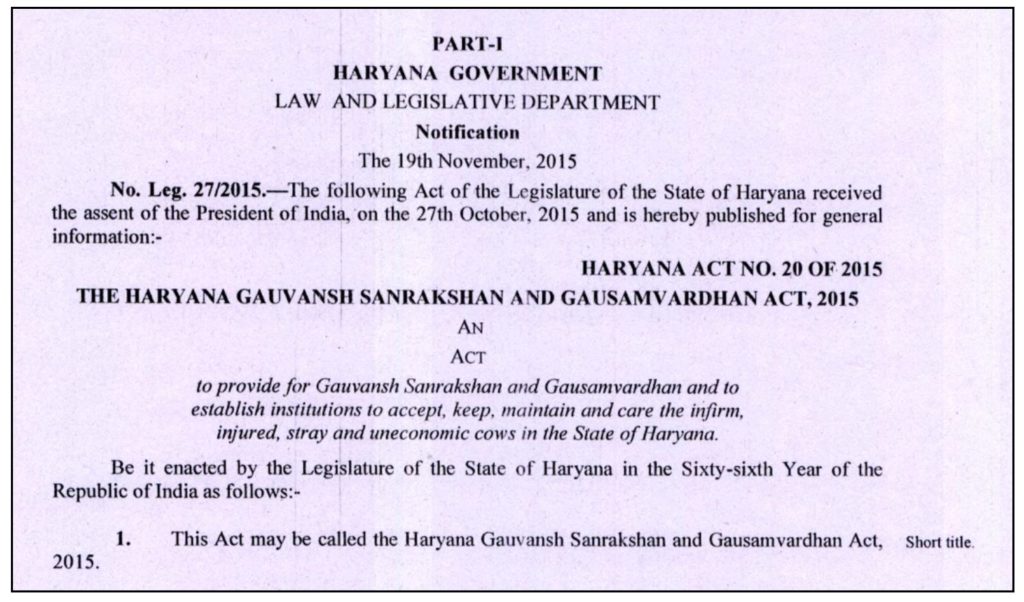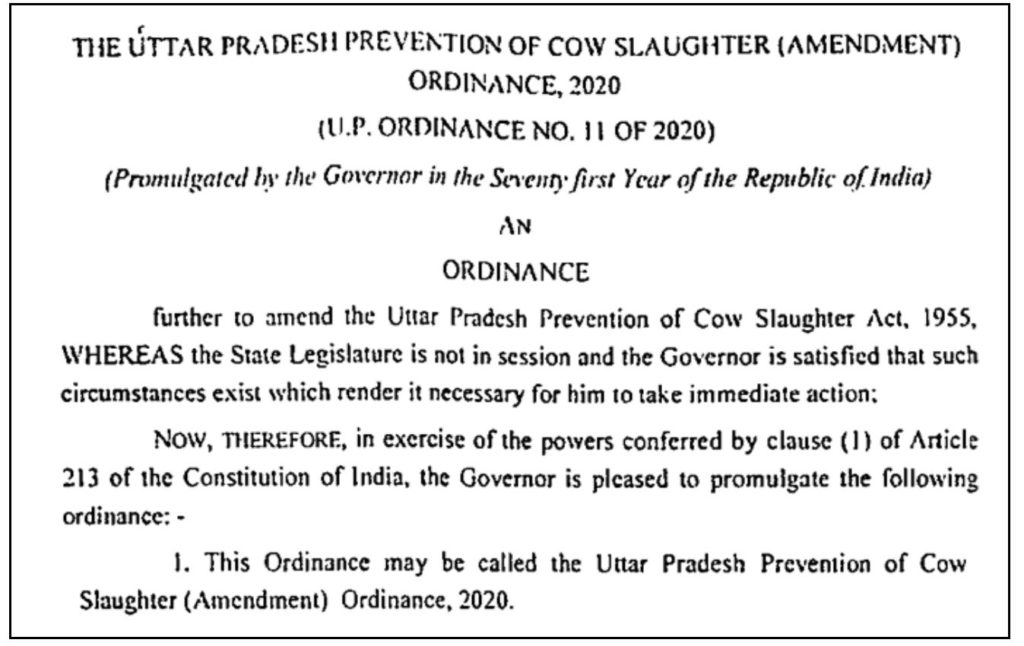Karnataka recently issued an ordinance aimed at the prevention of cow slaughter. In recent times, a few other states have also made changes or enacted new laws related to the prevention of cow slaughter. Here is a review.
Recently, the State Cabinet of Karnataka approved the ‘Prevention of Slaughter and Preservation of Cattle Ordinance (2020)’, which was earlier passed in the Karnataka State Assembly on 09 December 2020. The state government preferred an ordinance since it is yet to be approved by the Karnataka Legislative Council. This bill is a revised version of a Bill passed in 2010 by the then BJP government in the Karnataka Assembly. However, that bill was not approved eventually and was shelved by the Congress-led government in 2013.
The current bill is more stringent in the case of offences and expansive in its definition compared to the existing ‘The Karnataka Prevention of Cow Slaughter and Cattle Preservation Act, 1964’. While the existing bill allowed for slaughter of bullock, male/female buffalo if certified by a competent authority, the new bill passed in 2020, has deemed slaughter of any Cattle as illegal (i.e. not just Cows).

Apart from Karnataka, Haryana and Uttar Pradesh also brought about changes in anti-cattle slaughter laws in recent years.
5 states do not have any specific laws for slaughter of cattle especially Cows
As per the distribution of legislative powers between the Union and the State as per Article 246 of the Indian Constitution, the preservation of Cattle comes under the States’ list and the individual states have exclusive powers to bring in legislation. It is entry 15 as part of the items under State List.

While the Constitution of India does not authorize the centre to make any law on this aspect, it is mentioned in the Directive Principles of State Policy under Article 48.

Responding to a question in the Rajya Sabha on 26 July 2019, the government stated that with the exception of 5 States (Kerala, Arunachal Pradesh, Meghalaya, Mizoram & Nagaland) and 1 Union Territory i.e. Lakshadweep, the rest of the States/UTs have legislation on the slaughter of cows.
Even among the States where related legislation exists, there are differences in the scope of the law and the punishment for offences. Furthermore, while there are laws preventing the slaughter of cow and cattle (with a varying definition of what is included in the scope), there is no explicit legislation which prevents the consumption of beef.
- In States/UTs including Delhi, Gujarat, Haryana, Himachal Pradesh, J&K, Punjab, Rajasthan, U.P & Uttarakhand, the slaughter of Cow and its progeny including bulls & Bullocks of all ages is completely banned.
- In Assam and West Bengal, the slaughter of cows is allowed for those over 10 years and 14 years respectively. In most of the states, cows and other cattle beyond an age are allowed for slaughter by the provision of a ‘Fit for slaughter’ certificate from a veterinary expert or state-specific conditions.
- While the laws are strict around the slaughter of cows in a few of the states, the slaughter of buffalo is permissible under the law under certain conditions. (For example, Gujarat, U.P, etc. allow for the slaughter of buffaloes)
- In general, the slaughter of calves is prevented across all definitions of Cattle.
- States like Himachal Pradesh, J&K (including Ladakh) & Chhattisgarh make the slaughter of buffalo a cognizable offence. Karnataka with its new legislation joins these states.
The nature of offence also varies among the states. In few of the States/UTs – Delhi, Goa, Haryana, Himachal Pradesh, Punjab, Puducherry, Rajasthan, U.P & Uttarakhand, any violation of the law relating to cattle slaughter is considered as both cognizable and non-bailable offences. In the rest of the states, the violations are cognizable offences.
Gujarat, Haryana & U.P made changes to the legislation in the last decade
Most of the legislations by the states date back to a few decades. Apart from Karnataka, three States i.e. Gujarat, Haryana, & U.P made changes to these legislations in recent times.
Gujarat:
Gujarat passed “The Gujarat Animal Preservation (Amendment) Act, 2011” in its legislative Assembly in 2011. This act is a further amendment to “Gujarat Animal Preservation Act, 1954”

While the earlier law prevented the slaughter of cows, calves, bulls & bullocks, the slaughter of buffaloes was permitted under certain conditions and any violations were treated as a cognizable offence with the punishment of – imprisonment up to 6 months, or a fine up to Rs 1 thousand or both.
The new legislation brought about in 2011 makes the following changes:
- Criminalization of transportation of animals for purpose of slaughter and allows for the confiscation of vehicles carrying cow meat.
- The offences were made non-bailable
- The 2011 act initially provided for a maximum jail term for the slaughter of cattle to 7 years and a fine of up to Rs. 50 thousand. An amendment made in 2017, increased the punishment to “a minimum of 10 years and maximum of life term of 14 years” and along with an increase in a fine ranging from Rs. 1 lakh – Rs. 5 lakhs.
Haryana
In 2015, the State government of Haryana brought into effect the “Haryana Gauvansh Sanrakshan and Gausamvardhan Act, 2015”. This act replaces the earlier “The Punjab Prohibition of Cow Slaughter Act, 1955” which was also applicable to Punjab, Chandigarh & Himachal Pradesh (constituents of Punjab state before division)

- The Slaughter of Cow and its progeny including – bull, bullock, ox, heifer, the calf is completely prohibited.
- Export of cattle for slaughter and sale of beef are both prohibited.
- The sale of beef even if it’s imported is banned.
- The export of Cows is allowed by the provision of special permits, but export to states where there is no -cow slaughter ban is not permitted.
- The killing of cows by accident or in self-defense is exempted.
- There is no penalty for the consumption of beef.
- Any violation is treated as a cognizable & non-bailable offence
Even before enacting this new legislation, the punishment for offences in Haryana had stricter penalties than the other two states (Punjab & H.P) & Chandigarh. As per the current law, any violation can attract rigorous imprisonment of up to 10 years or fine up to Rs. 1 lakh or both. The new legislation places the burden of proof on the accused.
Uttar Pradesh
The Uttar Pradesh Prohibition of Cow Slaughter Act, 1955 completely prohibits the slaughter of cows. The transportation of cows outside the state for slaughter is also not allowed. Consumption of beef, defined as the flesh of cow (including bull or bullock) is prohibited but flesh in sealed containers imprinted into U.P is exempt.
The law considers any violation as a non-bailable and cognizable offence. The earlier legislation also permitted for the slaughter of Bull/bullock on obtaining a “Fit-for-slaughter certificate’, provided that it was over 15 years of age and has become permanently unfit for breeding or any agricultural activities.
- However, in 2001 the Government of Uttar Pradesh has issued an ordinance that prohibits the slaughter of Cow and its Progeny.
- In 2017, the UP government has issued a directive to the State police to take action against Cow slaughter and Cattle smuggling under National Security Act and Gangster Act.
- In June 2020, the Uttar Pradesh Government cleared the “Uttar Pradesh Prevention of Cow Slaughter Amendment Ordinance, 2020”

As per this new ordinance, the first offence can attract rigorous imprisonment of 1-10 years and a fine between Rs. 1-3 lakhs. A second offence would entail rigorous imprisonment of 10 years and a fine of up to Rs. 5 lakhs. Few of the other provisions include:
- Illegal transportation of cows and other bovines would result in the driver, operator, and owner being charged under the new act unless otherwise it is proven that the transportation was done without the owner’s knowledge.
- It also has provisions for recovery of maintenance of the captured cows from the owners of the vehicle for a period of one year or until the bovine is released.
The stated intent of the new legislations in these states is to ensure the protection of cows and other bovine population. However, the non-uniformity in the laws across the states creates a situation of illegal transportation to the states where slaughter is allowed. There are also accusations from human rights groups and civil society that the laws are being misused. In addition, there are challenges in the implementation of these laws since most farmers and cattle rearers find it difficult to maintain the cattle beyond their productive age.
In the next story, we take a look at the bovine population of the country based on the livestock census and analyse if there is any impact of these laws on the bovine population in various states.
Featured Image: Prevention of Cow Slaughter


